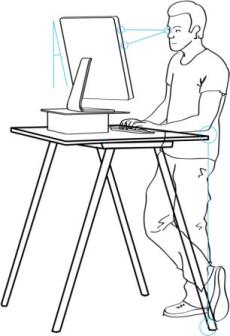Standing desks have a become very popular in many offices. Early studies show they can be highly beneficial for health and productivity; especially those that you can adjust between standing and sitting. Below are 6 tips for using your standing desk correctly so that you can maximize the benefits and minimize the negative effects.
Alternate between Sitting and Standing – Numerous studies have shown the negative effects of sitting but that doesn’t mean you should stand all day. Standing for long periods is thought to negatively affect your leg muscles, tendons and connective tissue. This can all be avoided by simply alternating between sitting and standing. The research is still in its early stages, but a ratio of 1:1 or 2:1 sitting vs. standing time appears to be optimal for comfort and energy levels, without affecting productivity. Put simply – for every 1 to 2 hours you sit in your office, 1 hour should be spent standing.
Adjust your Desk and Screen – Correct desk height and computer screen position are fundamental for improving comfort and minimizing risk. To begin, set your standing desk at about elbow height. This means your elbows should be in a 90-degree position from the floor. As a guide, the average 5’11” person would have their desk about 44 inches high. Recommendation for screen position are not black and white, but the general consensus is to have it 20-28 inches from your face. As a quick reference, it is said you should stand no less than the length from the tip of your middle finger to your elbow away. The top of the screen should be eye level, with a small upwards tilt of between 10-20 degrees. You should never need to tilt your neck up or down.
Purchase an Anti-Fatigue Mat – Anti-fatigue mats are commonly used in jobs that require extended periods of standing. Studies show that people who stand for 2 or more hours per day report less discomfort and tiredness when using anti-fatigue mats.
Change your Keyboard and Mouse Position – Working long hours on the computer can strain your wrists. The ideal angle when standing is slightly more extended (tilted upwards) than when sitting. A failure to consider this difference in those who frequently swap between sitting and standing has been shown to lead to greater wrist pain and discomfort. In order to protect your wrists when standing, always keep your keyboard and mouse at the same level, and your wrists straight when typing. The ideal wrist position differs between standing and sitting, so consider this when using your standing desk.
Use Arm Supports – An arm support is soft padding or surface area that attaches to your desk. It is designed to reduce pressure on the wrist that operates the mouse. Numerous studies show arm supports can significantly reduce the risk of developing neck and shoulder problems. Attaching an arm support to your desk may help with shoulder and neck problems, especially on your dominant side.
Remember to Take Breaks – Yes, standing is better than sitting but you still need to take regular breaks. Get up and move, rest your eyes and stretch. Some people remember to take breaks while others need an automated reminder. There are many free versions of reminder software you can download.
http://www.physioanswers.com/2016/03/6-tips-to-use-standing-desk.html

